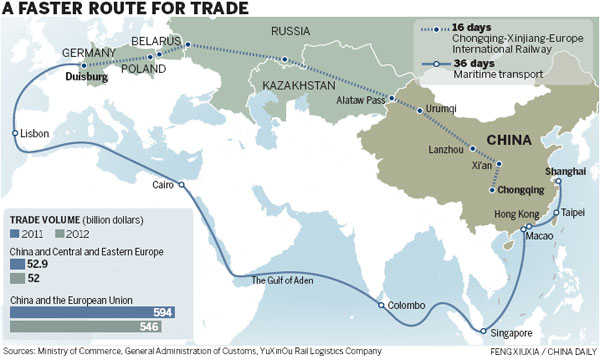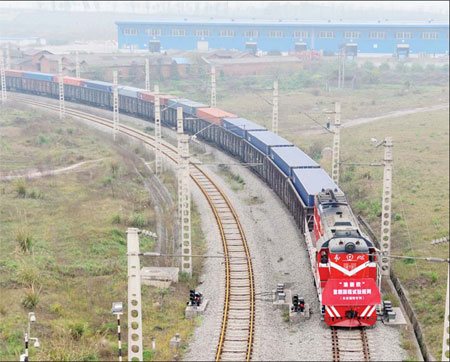All aboard the trade express
Updated: 2013-08-30 10:01
By Zhou Wa (China Daily)
|
|||||||||||
|
A train from Europe carrying auto parts arrives in Chongqing. Liu Chan / Xinhua |
Railway line adds new strand to china's links with european industry
For Andrei Dashkevich the opening of the Chongqing-Xinjiang-Europe International Railway was a boost to business, shortening the time and cost of transporting clothes from China to customers in his country.
"The re-energized Silk Road has also energized my business," he says of the line, which reduced the freight transport time to Belarus from 35 days to less than two weeks.
Dashkevich is not alone in benefiting from the rail line. A host of others across Asia and Europe have also felt its impact.
With shorter transport times and lower costs, international rail lines linking Central and Western China with Central and Eastern Europe are helping to improve trade between the regions.
Starting in Chongqing, the Chongqing-Xinjiang-Europe International Railway passes through Xi'an, Lanzhou, Urumqi and the Alataw Pass, where it enters Kazakhstan, before continuing through Russia, Belarus, Poland and finally ending in Duisburg, Germany.
Stretching 11,179 kilometers, it takes just 16 days on average to transport goods from China to Europe by rail, 20 days less than by ocean from China's eastern ports, which makes rail ideal for goods with a shorter shelf life.
The cost is one-fifth that of transporting cargo by air and there is just one customs inspection from Chongqing to Europe.
Since it began operating in 2011, the cost of transporting goods on the line has also fallen, from 80 US cents per 22 tons for every kilometer, to 70 cents.
The rail line transports a range of goods including electronics, cars, and medical equipment from China to Europe.
It has been compared with the second Eurasian Continental Bridge, a train line that starts at Lianyungang in East China's Jiangsu province and passes through the Alataw Pass in Xinjiang before ending in Rotterdam in the Netherlands.
The Chongqing-Xinjiang-Europe International Railway links Europe to South China's manufacturing hub and Southwest China's industrial belt.
"The freight volume of the Chongqing-Xinjiang-Europe International Railway has increased and its customer rating in Russia's railway system is going to be improved," a general manager from Gorky Branch of Russian Railway Container Corporation told Chinese reporters on a media tour along the railway.
With the rapid development of Sino-Russian economic and trade relations in recent years, an increasing number of Chinese goods have been distributed by Nizhny Novgorod Railway Station directed by Gorky branch, with average annual growth of 8 percent.
Of 2,627 containers that passed through the station in the first half of this year, 846 came from China, carrying building materials, cars, daily goods and chemical products.
The manager also revealed that his company is considering offering the railway preferential treatment, meaning the cost of transporting goods on it may be further reduced.
In a meeting of China and Central and Eastern European countries in Chongqing in July, Victor Ponta, prime minister of Romania, spoke highly of the Sino-Euro railway, saying the line will contribute to the quality of people's lives along it.
Tadeusz Chomicki, Poland's ambassador to China, has also shown interest in increasing trade with China via the railway.
Poland has a strong food processing industry, with most products sold to the US and Western Europe.
"We hope our meat products can also reach the Chinese market," the ambassador says.
The railway line has been a particular boost to Chongqing. According to Yuxinou Logistics, which provides logistics services along the railway, from January to May this year, freight transported out of Chongqing rose 5.9 percent, and freight into the city rose 8.3 percent.
China and countries in Central and Eastern Europe can benefit greatly from increased trade, observers say, as European countries look to diversify their economies. Chinese investment can help to stabilize markets and quicken economic recovery in Central and Eastern Europe, says Zhao Junjie, a researcher on European studies with the Chinese Academy of Social Sciences.
China's fast development offers a huge market for Central and Eastern European countries, which can help increase the countries' exports, Zhao says.
However, challenges still exist. Most freight from China's coastal cities to Central and Eastern Europe is still taken by ship to Rotterdam, and then transferred by air or road, says Huang Qifan, mayor of Chongqing.
To maintain the rail line a steady supply of imports and exports along it is required, but the Chongqing-Europe railway currently lacks many exports from European countries. Chongqing is trying to solve this by promoting the line to Europe.
In March, the first return train along the railway came back from Duisburg, bringing auto parts from Germany to a China-based joint-venture between US automaker Ford and its Chinese partner Chang'an.
The railway is now operating at a frequency of one or two trains a week. By the end of this year, this will be increased to three times a week and one a day by the end of next year.
In addition, the operator plans to enhance reloading efficiency when changing from the narrow rail gauge in China to broad gauge in Russia and Europe. Transportation time will also be shortened to about 13 days.
Beside the Chongqing-Xinjiang-Europe railway, another line linking Asia and Europe was launched in July, from Zhengzhou, a business and logistics center in Central China, to Hamburg, Europe's second largest port.
The route reaches Germany via Kazakhstan, Russia, Belarus and Poland taking 18 days to cover the 10,214 km, more than twice as fast as it would take by sea.
It is also about 80 percent cheaper than air transport and significantly cheaper than transporting by road.
Like the line linking Chongqing and Duisburg, the Zhengzhou-Europe railway has to transfer from different gauges twice, which is completed by crane.
The first transfer is a change to the Russian broad gauge line at the Alataw Pass on the border between China and Kazakhstan in northeastern China's Xinjiang Uygur autonomous region. The second is a transfer to standard gauge at the Polish-Belarusian border.
The gauge transfer and technical service is provided by DB Schenker, the transport and logistics arm of Germany's national railway Deutsche Bahn, through its service network in Central Asia and Eastern Europe after the trains leave China.
The company is also the rail route's main partner outside China.
The first freight train along this route had 41 containers, including 11 of vehicle parts, industrial yarn, high-end shoes and clothing on route to Hamburg, 29 containers of abrasive headed to Belgium's Antwerp and one container of garments destined for Rotterdam. The goods were valued at $2.33 million.
zhouwa@chinadaily.com.cn

(China Daily European Weekly 08/30/2013 page20)
Today's Top News
List of approved GM food clarified
ID checks for express deliveries in Guangdong
Govt to expand elderly care
University asks freshmen to sign suicide disclaimer
Tibet gears up for new climbing season
Media asked to promote Sino-Indian ties
Shots fired at Washington Navy Yard
Minimum growth rate set at 7%
Hot Topics
Lunar probe , China growth forecasts, Emission rules get tougher, China seen through 'colored lens', International board,
Editor's Picks

|

|

|

|

|

|






